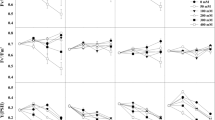Summary
The slow kinetics of chlorophyll fluorescence were examined in seven potato genotypes grown either fully irrigated or droughted from the time of plant emergence. Constant and variable fluorescence (F o andF v respectively) declined with time in plants from both irrigated and droughted treatments, but the decline was greater in droughted than irrigated plants. However, the yield of variable fluorescence (F v/(F o+F v)) was unaffected by the drought treatment. The main effect of drought was upon the quenching of variable fluorescence. Both the half life of the decay of variable fluorescence (q1/2) and the secondary maximum (M) were significantly greater in the droughted plants than in those from the irrigated treatment. Significant differences between genotypes were found forF v/(F o+F v),M andq 1/2. Genotype-by-treatment interactions were non-significant for all the variables examined. Changes in chlorophyll fluorescence transients were not closely related to changes in leaf water potential.
Similar content being viewed by others
References
Conroy, J.P., R.M. Smillie, M. Küppers, D. Bevege & D.I. Barlow, 1986. Chlorophylla fluorescence and photosynthetic and growth responses ofPinus radiata to phosphorus deficiency, drought stress, and high CO2.Plant Physiology 81: 423–429.
Di Marco, G., A. Massacci & R. Gabrielli, 1988. Drought effects on photosynthesis and fluorescence in hard wheat cultivars grown in the field.Physiologia Plantarum 74: 385–390.
Greaves, J.A. & J.M. Wilson, 1986. Assessment of the non-freezing cold sensitivity of wild and cultivated potato genotypes by chlorophyll fluorescence analysis.Potato Research 29: 509–520.
Havaux, M., M. Ernez & R. Lannoye, 1988. Correlation between heat tolerance in cereals demonstrated by rapid chlorophyll fluorescence tests.Journal of Plant Physiology 133: 555–560.
Havaux, M. & R. Lannoye, 1983. Chlorophyll fluorescence induction: a sensitive indicator of water stress in maize plants.Irrigation Science 4: 147–151.
Havaux, M. & R. Lannoye, 1985. Drought-resistance of hard wheat cultivars measured by a rapid chlorophyll fluorescence test.Journal of Agricultural Science, Cambridge 104: 501–504.
Jefferies, R.A., 1992. Effects of drought on chlorophyll fluorescence in potato (Solanum tuberosum L.). II. Relations between plant growth and measurements of fluorescence.Potato Research 35: 35–40.
Jefferies, R.A. & D.K.L. MacKerron, 1987. Aspects of the physiological basis of cultivar differences in yield of potato under droughted and irrigated conditions.Potato Research 30: 201–217.
Jefferies, R.A. & D.K.L. MacKerron, 1989. Radiation interception and growth of irrigated and droughted potato (Solanum tuberosum).Field Crops Research 22: 101–112.
Jones, H.G., 1990. Control of growth and stomatal behaviour at the whole plant level: effects of soil drying. In: W.J. Davies & B. Jeffcoat (Eds). Importance of root to shoot communication in the responses to environmental stress. Monograph 21, pp 81–93, British Society for Plant Growth Regulation, Bristol.
Krause, G.H. & E. Wies, 1984. Chlorophyll fluorescence as a tool in plant physiology. II. Interpretation of fluorescence signals.Photosynthesis Research 5: 139–157.
Schapendonk, A.H.C.M., C.J.T. Spitters & P.J. Groot, 1989. Effects of water stress on photosynthesis and chlorophyll fluorescence of five potato cultivars.Potato Research 32: 17–32
Schreiber, U. & W. Bilger, 1987. Rapid assessment of stress on plant leaves by chlorophyll fluorescence measurements. In: J.D. Tenhunen et al. (Eds), Plant Response to stress. NATO ASI series Vol. G15, p 27–53. Springer-verlag, Berlin.
Sinclair, T.R. & M.M. Ludlow, 1985. Who taught plants thermodynamics? The unfulfilled potential of leaf water potential.Australian Journal of Plant Physiology 12: 213–217.
Sivak, M.A. & D.A. Walker, 1985. Chlorophyll fluorescence: can it shed light on fundamental questions in photosynthetic carbon dioxide fixation?Plant, Cell and Environment 8: 439–448.
Smillie, R.M. & S.E. Hetherington, 1983. Stress tolerance and stress-induced injury in crop plants measured by chlorophyll fluorescence in vivo. Chilling, freezing, ice cover, heat and high light.Plant Physiology 72: 1043–1050.
Vos, J. & P.J. Oyarzún, 1987. Photosynthesis and stomatal conductance of potato leaves-effects of leaf age, irradiance, and water potential.Photosynthesis Research 11: 253–264.
Author information
Authors and Affiliations
Rights and permissions
About this article
Cite this article
Jefferies, R.A. Effects of drought on chlorophyll fluorescence in potato (Solanum tuberosum L.). I. Plant water status and the kinetics of chlorophyll fluorescence. Potato Res 35, 25–34 (1992). https://doi.org/10.1007/BF02357719
Accepted:
Issue Date:
DOI: https://doi.org/10.1007/BF02357719




